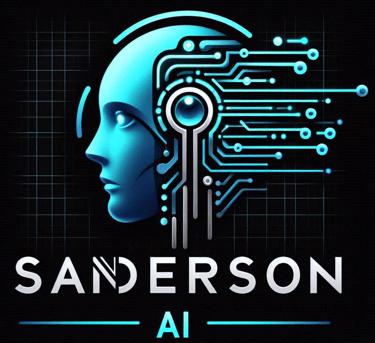AI Assurance Isn’t Optional Anymore
Here Is Why the Last 48 Hours Proved It -This article explores why AI assurance is now essential across sectors like financial crime, healthcare, finance, and public services. With new developments from the Big Four and ICAEW, it outlines what AI assurance means, who needs it, and how to get started—offering a practical roadmap for compliance, trust, and long-term resilience.
By Christian Sanderson – Creator, Sanderson AI Formatted by Chat GPT
7/4/20253 min read


AI assurance has just become a boardroom topic.
In the past 48 hours, two events have changed how AI oversight is viewed across industries.
The Big Four accountancy firms have publicly launched dedicated AI audit services. At the same time, the Institute of Chartered Accountants in England and Wales (ICAEW) hosted its first AI Assurance Conference, setting out what credible oversight now looks like in practice.
These developments signal the next phase in AI adoption. Any organisation using AI to influence financial decisions, automate access to services, or support regulated processes now needs clear, independent assurance.
Big Four firms enter the space
The Financial Times reports that Deloitte, EY, PwC, and KPMG are all launching AI audit services.
PwC UK has already delivered assurance reviews for several clients. These checks focused on fairness, explainability, and alignment with risk policy.
Deloitte and EY are building frameworks that cover the full model lifecycle. KPMG is investing in tooling to evaluate governance, accountability, and real-world performance.
These are not one-off code reviews. These firms are testing for bias, output accuracy, audit trails, and compliance with regulation.
In sectors like finance, healthcare, and infrastructure, this level of assurance is quickly becoming expected.
ICAEW sets the foundation
At ICAEW’s conference on 2 July, AI assurance was defined as an evidence-based process.
It evaluates whether an AI system:
Works as intended
Aligns with legal and ethical standards
Supports human oversight and accountability
Professor Lukasz Szpruch explained that assurance connects system goals with actual behaviour. It involves developers, risk leads, users, and external reviewers.
The message was clear: assurance is not internal risk reporting. It is an externally visible structure of proof.
Which sectors need to act now
AI assurance is no longer a niche topic. It is now critical in multiple sectors, including:
Financial crime
AI tools are used to detect fraud, screen transactions, and flag suspicious behaviour. If they are biased or opaque, they risk fines and failed audits.
Healthcare and life sciences
AI influences diagnostics, patient triage, and drug discovery. Without oversight, these systems can fail safely or unfairly.
Banking and insurance
AI is used in credit scoring, risk profiling, and claims automation. It must be explainable and fair, especially under FCA rules.
Public services
AI supports decisions in housing, benefits, policing, and education. Trust depends on external validation and transparency.
Retail and e-commerce
Algorithms drive pricing, recommendations, and customer engagement. Poorly governed AI erodes brand trust.
Technology providers
Vendors selling AI tools are now being asked to prove governance. Assurance is becoming part of procurement due diligence.
Why this matters right now
Three forces are raising the stakes.
1. Regulators are already watching
The UK government expects sector regulators to supervise AI use. No new laws are needed for enforcement to begin.
2. Board-level liability is rising
Executives can now be held responsible for AI failures. Without assurance, the legal burden shifts upwards.
3. Buyers are asking for proof
Firms in procurement and finance are starting to demand AI assurance reports before signing contracts.
What assurance actually includes
This is not theoretical. Modern AI assurance focuses on clear areas:
Explainability – Can decisions be traced?
Bias and fairness – Are outcomes consistent across groups?
Security – Is the system hardened against misuse?
Governance – Who owns it, and how is it monitored?
Reliability – Does it perform under real-world conditions?
Incident response – What happens when it fails?
These areas are already part of reports being produced by PwC and others.
How to begin assurance now
If you use AI, take these four steps:
Step 1: Map your systems
List all AI tools that influence decisions or customer outcomes.
Step 2: Identify risk
Prioritise systems that touch money, people, or legal status.
Step 3: Choose your path
Large firms may go to Deloitte or Intertek. Smaller teams can start with open-source tools and internal reviews.
Step 4: Document everything
Capture training data sources, model behaviour, known risks, and mitigation steps. This forms your audit trail.
What to expect in 2025
AI assurance is growing fast. Over the next year, expect:
Contracts requiring assurance reports
Board-level dashboards on AI risk
Sector-specific checklists aligned with UK policy
Tools to automate parts of the assurance process
ISO 42001 becoming a baseline standard
Coming soon from Sanderson AI
Intertek vs Big Four vs RegTech: AI assurance comparison
The 7-day guide to launching an assurance programme
Sector checklists for financial crime, healthcare, and critical infrastructure
Image placeholder: Team reviewing model outputs in an assurance workshop
Conclusion
AI assurance is no longer optional.
It is how serious organisations prove their systems are safe, lawful, and aligned with public trust.
Firms that adopt assurance early will avoid risk, gain credibility, and stay ahead of regulation.
Those that delay will be forced to catch up at a higher cost.
If your AI influences outcomes, you must be able to prove it is explainable, secure, and fair.
Written by Christian Sanderson – Creator, Sanderson AI
Formatted by Chat GPT
